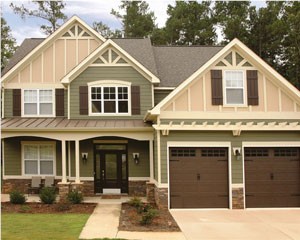
Siding is a critical investment for any homeowner to consider when upgrading their home or building a new one. After all, a well-made product and high-quality siding installation can bring many important benefits to enhance your property, including enhanced indoor comfort, better protection against the elements, greater energy savings, and heightened aesthetic and curb appeal.
Today’s siding market offers a great variety of amazing options to choose from apart from the traditional wood selections. This means that homeowners have the luxury of weighing the pros and cons of several materials for siding, and can count on finding an excellent and affordable option for their homes.
Replacement siding is available in multiple materials that vary in cost and installation methods, and each of them can be defined by their own distinct strengths and weaknesses. There are also extra features to consider, such as insulated siding, which can make the decision even more complicated and overwhelming for the average homeowner hoping to receive the best possible value for their money.
By working with professional siding contractors like the team at Midwest Construction, you can get professional insight into the best siding option that’s right for you and your home. Before getting in touch with your siding company, take a moment to review this comprehensive introductory guide we’ve provided for you. In this guide, you’ll learn everything you need to know about siding and siding replacement in order to prepare yourself for your upcoming exterior home improvement project.
What is Siding?
Before going any deeper into the topic, let’s take a moment to discuss exactly what siding actually is. At its most basic level, siding is the skin of your home. It’s the material used to promote excellent curb appeal and maintain and improve resale value.
More importantly, siding also serves a crucial functional purpose. The siding along with the roof is the first layer of protection against inclement weather and other environmental concerns. A lack of high-quality effective siding can leave the home unprotected and cost homeowners greatly in the future.
Important Features to Look For in High-Quality Siding Products
Different materials have different standards when it comes to what constitutes high quality. For example, vinyl siding is great at protection against mold and rot but will melt in extreme heat. Wood, on the other hand, has the opposite problem. Wood won’t melt, but it will attract mold and absorbs moisture—unless the product is pressure-treated to a sufficient degree.
Those are just two examples of the pros and cons of two siding materials, which we’ll go into detail later in this article. All materials have pros and cons, however, it is important to note that quality is the most important factor regardless of the material chosen.
Below are some key features of high-quality siding that set them apart from their lower quality counterparts.
- Double-Hem Nailing Area: With vinyl siding primarily, you want there to be a double-hem nailing area. This equals a stronger attachment to the house and better wind resistance compared to the single-layer helm. This concept applies to any lightweight siding option.
- Extra-Long Panels: The longer the panel, the lower the number of seams. This is important as more seams can mean more opportunities for water to leak inside.
- Finish: Factory finishes are often color-treated and last longer than finishes performed after the installation. Go with a pre-finished option if greater durability is more important than added color options.
- Foam Backing: Many siding options lack either the strength to minimize its flexibility (vinyl, aluminum) or lack insulating properties (steel). Foam backing is an option that reduces these concerns.
- Energy-Efficient Features: Saving on the energy bill is always a priority. Many options offer additional insulation to promote improved energy efficiency making the home livable and less expensive down the road.
- Eco-Friendly Materials: Many homeowners desire to go green and with higher quality siding that’s an accessible option. The key word is sustainability. Pick materials that require minimal energy and resources to make along with options that recycle.
Choosing Your Siding Products
Making a decision regarding what siding material should be chosen is a big one that should not be made lightly. Most siding is meant to last for a minimum of 20 years with most lasting for much longer with proper maintenance and upkeep. This means that the siding chosen needs to be one that homeowners can live with for such a long period of time according to their maintenance preferences, climate, and other factors.
Naturally, there are numerous options available. Vinyl, brick, steel, cellular PVC, and fiber cement are just a few options available to homeowners. When choosing the right material, homeowners should be prepared to ask their contractor pointed questions. Here are some of the questions to consider asking your contractor before deciding on a siding material:
- Which material is right for my particular house style and structure?
- Which material responds best to the climate we live in?
- What option offers a compromise between installation ease, beauty, durability, and cost?
- Should I consider insulated siding?
- What about warranties and guarantees on materials, installation, and finish?
Synthetics vs. Natural Materials
Another important factor to consider is whether you want “real” materials or synthetic materials. Both options are equally represented and offer their own pros and cons. Some synthetic options, which includes vinyl and fiber cement siding are some of the most popular options, while others like synthetic stucco and stone are less popular but still in demand.
The difference in popularity stems primarily from two things:
- How little history is available with some synthetic options. This is less and less important today, as most synthetic materials have been tried, tested, and proven to perform well in many conditions.
- Synthetic materials have yet to truly match the look of the natural material it’s trying to replace, although many people can’t tell the difference.
Types of Siding
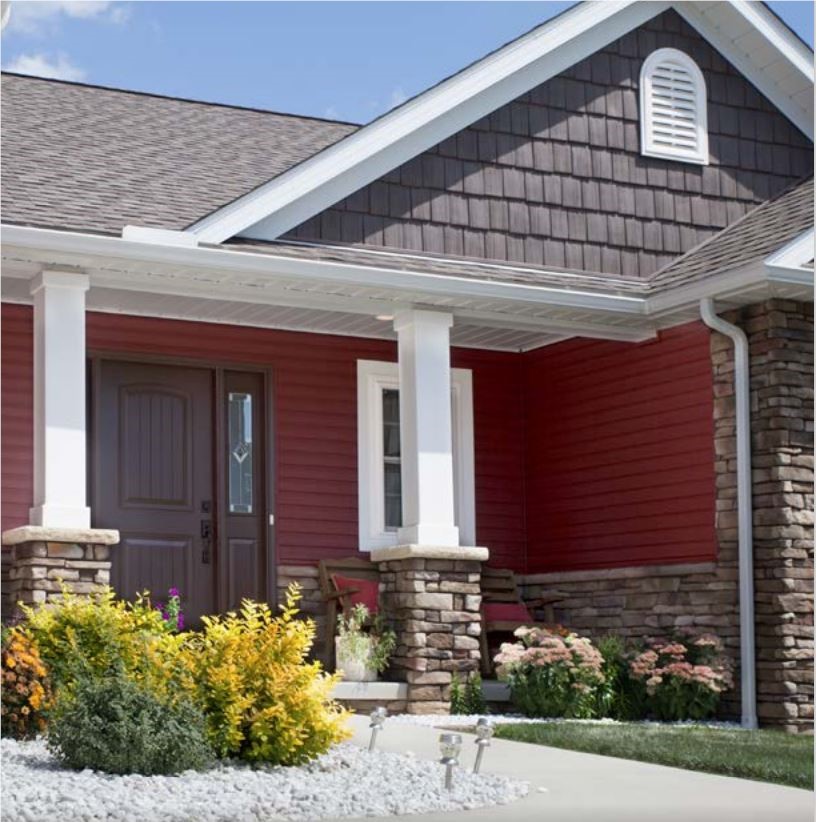
There are several types of siding that are commonly used today. Choosing between them means getting to know more about each option, weighing the pros and cons, and determining your budget and style preferences. Your choices for siding materials include:
- Vinyl: Excellent durability, low maintenance, and affordability are just some of the reasons why vinyl siding is such a popular siding choice for homeowners. Often this option is installed with foam backing for improved energy efficiency and wind resistance. Plus, it lasts for a long time with proper care. However, vinyl melts in hot temperatures and cracks easily in cold conditions. Be wary of the range in the quality present with vinyl, and only buy premium siding products from highly rated manufacturers and contractors.
- Plastic: Technically, vinyl is also plastic siding, but the main difference lies in how plastic siding is made compared to vinyl siding. Plastic siding is made from polypropylene resin whereas vinyl is made from PVC. Plastic siding is made via an injection molding process that allows it to be shaped and textures to look like other materials more easily. However, vinyl is more widely available and established in the siding industry.
- Fiber Cement: Usually made to look like wood, this option is made of sand, cellulose fiber, and cement. The combo lends itself to offering a durable yet affordable package for homeowners, which has led to its increase in popularity. Plus, fiber cement siding is resistant to fire and termites making it a safer choice compared to some other options. The product is still new and untested compared to older options so it’s best to back the product with an outstanding warranty for additional protection.
- Wood: Wood is heralded as a classic and traditional choice for homeowners. There’s no denying that wood is beautiful—and the natural look of wood adds considerable charm and stunning curbside appeal to any home. It’s durable, resistant to inclement weather, and is suitable for most environments. However, wood is also expensive to install and maintain and is susceptible to fire and moisture problems. Homeowners in wet or wildfire prone environments might want to consider other options.
- Aluminum: Cost-effective and long-lasting, aluminum siding is also low maintenance and stylish. Plus, today’s aluminum siding products resist corrosion, making it suitable for wetter environments. However, it’s extremely lightweight and susceptible to impact dents as well as severe bending. It can also be quite noisy in the rain, although some homeowners love the sound of rain on an aluminum roof and can find it relaxing.
- Brick: Brick is a rare but beautiful siding option that offers curb appeal along with superior sound and temperature insulation. That being said, brick is heavy and requires a better than a solid foundation. In addition, the upfront costs of installing brick can be quite expensive. However, properly installed brick siding lasts for over 100 years so it could be a sound investment for the long haul.
- Stucco: Made from cement, hydrated lime, water, and epoxy, this option is popular in pueblo-style homes usually found on the west coast. While quite durable and long lasting it is costly and requires a lot of prep work and time to install properly.
- Steel: Steel offers similar benefits to its lighter cousin aluminum. Insects, rot, and fire are no match for steel siding. In addition, it’s low maintenance, durable, and more resistant to impact than aluminum and other lightweight materials. However, it can be scratched and rusts easily if not treated properly. Due to its heavier weight, DIY is not really an option and requires professional installation.
- Stone: Much like brick, stone—both natural and fabricated, offers an upscale yet durable appearance for the home. However, both options are heavy and will cost more while requiring a reinforced foundation for support.
Siding Replacement, Siding Repair, and New Siding Installation
No matter what material is chosen, the siding is only as good as the installation and maintenance routine supporting it. The siding is meant to keep the residents within the home protected, but without proper care, the siding becomes the first casualty against the elements. That’s why timely repairs and replacement as needed is necessary to extend the life of the siding and keep the home not only functional but also beautiful.
Most times, issues with the siding can be repaired instead of replaced. The trick is to catch the problems while they’re still small. Regular professional inspections can help catch these minor issues in time before replacement is needed. Examples of minor repair work include repainting, covering up scratches, re-caulking of seams, and other similar work. Keep in mind that repairs also occur by performing what is known as a partial replacement.
When a panel or board needs replacing, you can often get away with just replacing that one piece instead of a complete siding replacement. This can save money and time for homeowners who aren’t in a position to pay for a full replacement.
Sometimes a full replacement isn’t an option. The damage may be too severe or an underlying problem went unnoticed for too long. When that happens it’s important to be aware of the basic replacement and installation process, which we’ve outlined below.
- Materials delivered: Before installation can occur, the materials and supplies must be delivered to the job site packaged and wrapped to avoid damage. This typically includes a dumpster or dump trailer used to haul away old siding and packing.
- Old siding removal: Some contractors just cover up the problem and move on. Make sure the contractor chosen removes the old siding completely and performs needed inspections and repairs before installation begins. During this step, they will often prep the house before installing the new siding.
- Installation Begins: This step will depend on the siding material chosen. Every material is installed slightly differently and has different considerations involved. For example, fiber cement siding along with steel, stucco, and stone siding are all extremely heavy and need additional manpower and reinforcement to be installed correctly.
With Midwest Construction, the job site is cleaned up daily, and all tools, ladders, and planks are secured. Any leftover materials are collected and the dumpster or dump trailer is removed upon the completion of the project.
Warranty Information
Just like any other home remodeling project, new siding is an investment. Your siding needs to be protected from the moment of purchase to the moment of installation, and beyond, in order to encourage the long-term value of the investment.
A great siding warranty that covers materials, finish and installation are worth looking for and should be one of the first priorities to consider when shopping around for options. Not all warranties are the same, nor do they all cover the same thing. The key is to understand the basics of a viable siding warranty and then carefully review the warranty chosen.
With siding, the warranty is broken into two different kinds. One warranty covers the installation and the other covers the product itself. This is important for two reasons. Rarely are the two combined in one comprehensive warranty, meaning it’s important to verify that both are purchased. The second reason for its importance lies in what can go wrong with siding installation.
Siding is only as good as the installation. There is a correct way and an incorrect way to install the siding. The method will vary depending on the siding material, which is why it’s important to choose a contractor familiar with the siding material chosen. In addition, verify their work history, reputation, and local building codes along with manufacturer instructions to ensure the installation is done properly. Ideally, the warranty only becomes needed due to a legitimate mistake instead of a grievous error.
Even with established manufacturers, mistakes in the production of the siding can occur. The siding can break down prematurely or lose its color too soon, or any other issue that implies something went wrong with the product. The warranty keeps you protected so that you’re not stuck with defective siding and instead can get it replaced.
One thing that is universal with all siding warranties is that failure to perform regular and proper maintenance and care for your siding will often void the warranty. Even with low maintenance siding, it still needs to be taken care of. If you allow dirt, grime, and other materials to build upon the siding, then did the product fade or did you fade the product? That’s the question that will be asked by the company providing the warranty.
Fortunately, maintenance is rather easy to demonstrate with siding. In fact, if you set up regular inspections and maintenance with a professional contractor (ideally the same contractor you chose for the installation) you can rest easy knowing that the warranty will remain valid. Plus, let’s not forget the other benefit of a solid maintenance plan. Proper care will extend the life of your siding and keep it looking beautiful for decades. There is no better example of a win-win scenario than that.
Typical Siding Installation Costs
The good news is that a proper siding installation will help ensure that your siding has what it needs to last for up to 50 years. However, most homeowners will have to face a new siding installation at least once in their lifetime. Unexpected damage from weather and premature product breakdown are just a couple of examples of why this is likely.
When these situations occur, siding replacement is the only option. However, that doesn’t mean that homeowners should just jump in the deep end. It’s important to research how much the installation should cost so that you’re prepared from the start.
It’s important to remember that multiple siding options exist and that all high-quality materials offer a range of additional features and benefits. Everything from wood and vinyl siding to aluminum and fiber cement siding has its initial price point. These different price points will influence your final cost significantly. In addition, make sure to shop around for multiple quotes. The exact same material and installation process may have significantly different estimates depending on the contractor. This is largely due to the kind of overhead and margins the contractor is working with, but there are additional factors involved.
These additional factors also play a role in determining your cost:
- Quality: You can save money in the short-term by purchasing lower quality siding. However, higher quality siding like insulated siding is more durable and needs fewer replacements. You will have to decide which end of the equation you want to be on.
- Home Size: The bigger the house the more siding needed. In addition to the increased need for material, the amount of time taken is also increased meaning the labor costs go up as well.
- Geography: Different areas of the country have different costs. Where you reside along with the availability of different siding materials will play a role in your final cost.
- The Shape of Your Home: If the home has multiple stories, eaves, turrets, curves, or unique angles then you can expect to pay more due to the increased difficulty in installation.
- Removal: Some siding can have new siding laid over it and some require the old siding to be removed first. If the second option is needed, it will cost more for homeowners. This is largely due to the increased amount of time needed to complete the installation.
A final consideration is when you choose to get your siding replaced. Projects done in the off-season are generally cheaper than projects done during peak season. Basically, you can save money when the contractors aren’t in great demand.
Warning Signs to Replace Your Siding
To repair or to replace is a question asked often by homeowners. In all fairness, it can be tricky to determine when the fine line between repair and replacement is crossed. After all, deep cleaning and caulking take care of many surface issues and partial replacements can be performed easily with the homeowner moving on quickly. However, there are situations that occur that prompt nothing less than a full siding replacement.

These warning signs include:
- Leaks: The siding is supposed to protect against leaks. If problems like mold, rot, fungus, or any other growth are present, this signifies that significant water damage is occurring. At this point, siding replacement is practically mandatory. Some materials will warp or swell with water damage while others like steel will rust. Pay attention to how your chosen material reacts to the presence of water so you can act quickly.
- Damaged Boards or Panels: A damaged panel can be taken care of with a partial replacement. When the damage is widespread or has been unrepaired for a great length of time, then full replacement is needed. Damage can look like dents due to impact or with some materials such as wood, termites. With severe damage, prompt action is necessary to keep the home safe.
- Crack, Peel, and Fade: These conditions are signs of aging usually due to sunlight or harsh winters. Once the product starts showing its age, it’s only a matter of time before a full replacement is necessary. Also, if paint touch-ups don’t last for at least five years, it’s another sign that replacement is imminent.
- Water Stains: Sometimes the siding looks great visually and obvious signs aren’t present. That’s when it’s time to look within. In other words, if the walls inside the house show signs of water damage or mold it means the siding isn’t performing. This is actually a serious housing problem and needs immediate action.
- Higher Energy Bills: Small gaps and holes can lead to increased energy bills. Often unnoticeable, they are the silent culprits in poor home performance. If the energy bill is noticeably higher, check the roof and windows. If it’s not those, then it’s the siding.
Superior Siding Services from Midwest Construction
At Midwest Construction, we have supported our customers since 1958 through all of their siding needs. Our team of professionals performs everything from siding repair to replacement siding. We pride ourselves on our superior attention to detail along with unmatched customer service. As a Progressive Foam Partner that is VSI Certified, we can issue the siding factory warranty along with the Progressive Foam warranty for both product and installation so you know you’re covered.
Ready to look into replacement siding with our experts at Midwest Construction? Give us a call to speak with one of our agents about our professional siding services or fill out our online form to schedule your free, in-home pricing estimate now.
Subscribe to Midwest Construction's Blog





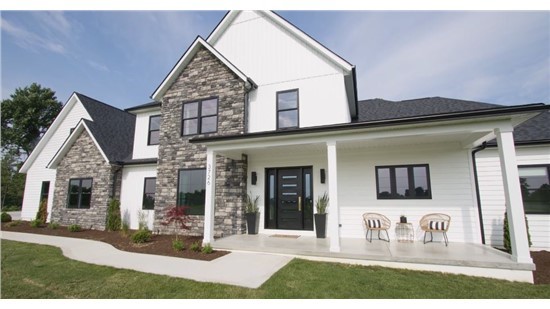
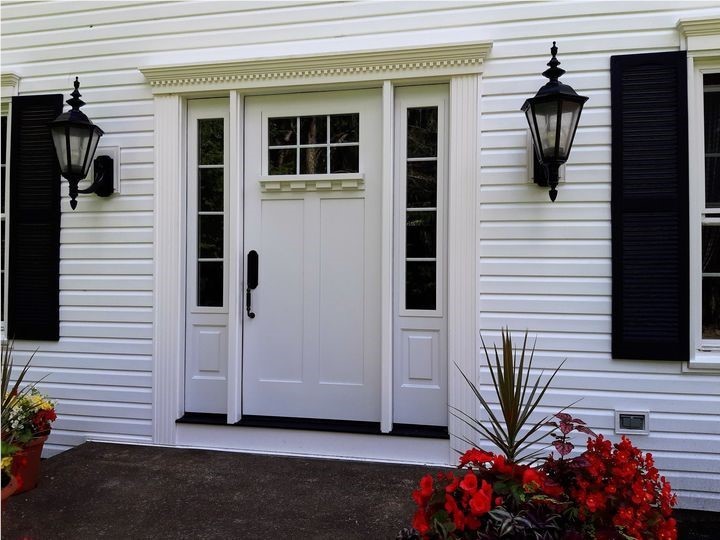
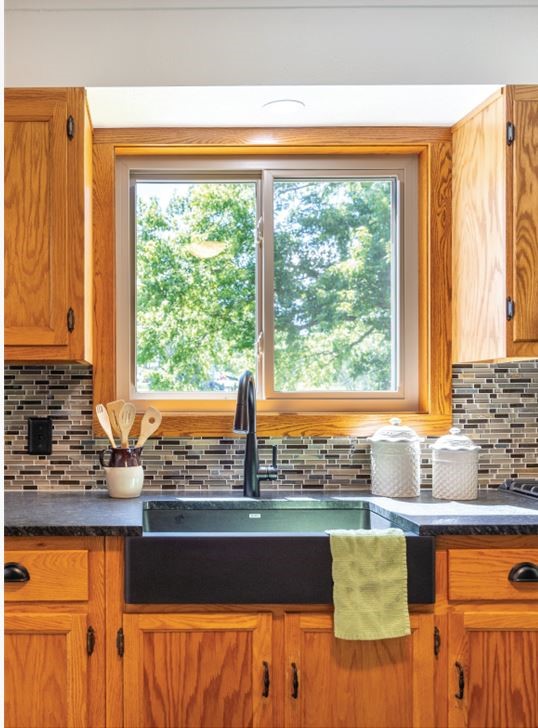
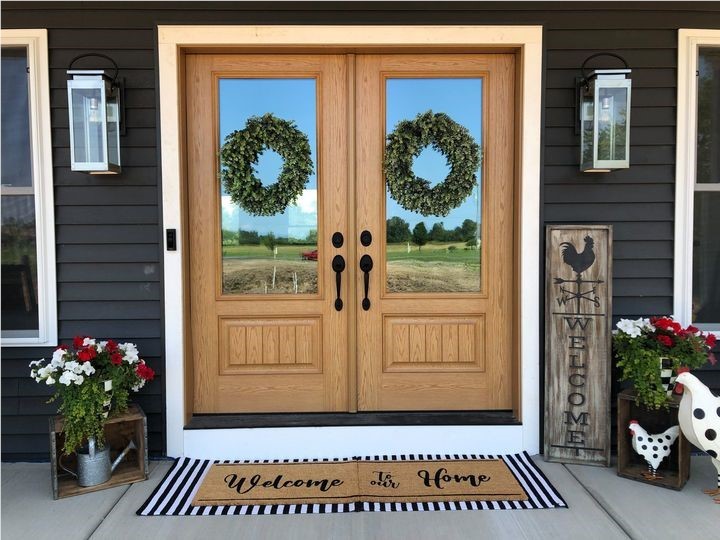

Comments